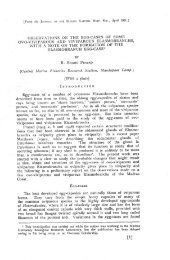PDF - Eprints@CMFRI
PDF - Eprints@CMFRI
PDF - Eprints@CMFRI
Create successful ePaper yourself
Turn your PDF publications into a flip-book with our unique Google optimized e-Paper software.
62<br />
X2: 10-14 is a cluster of folia , fro nds only 1.5 em wide. The details of calices as in EC 361. In both<br />
the specimens the ambulacra are flat.<br />
Mate r ial:<br />
Southern R. S. : HLM EC 36 1 (Massawa).<br />
X2: 10- 14 (Sarso Isl.).<br />
D is t r ib u t i 0 n: Red Sea; Somaliland ; Madagascar; Rodriguez (as P. lata); Reunio n; Gulf of Mannar<br />
(PI LLAI, 1972); Cocos-Keeling Isis.; Andamans (MATfHA I, 1924); Mergui Archipelago; Str. of Malacca;<br />
East Indies ; Ph ilippines; Palau Isis.; Caroline Isis.; Great Barrier Reef; Fiji; Samoa.<br />
R emarks: VAUG HAN (1918) thought P. angularis and P.laxa of KLUNZ INGER are the same as<br />
P. danai MI L E EDWARDS & HAIM E, while HOR T (1921) only identified laxa with danai and considered<br />
P. angularis a synonym of P. decusSllta. HOFFME ISTER (1925) merged P. danai with P. decussata, a course<br />
which helped VAUGHAN and HORST in uniformity. CROSSLAND (194 1), while writing on FORSKA L'S<br />
corals, fe lt that decussata and danai are different and agreed that FOR KAL's cactlls is the same as P. danai<br />
(vide infra!. We feel P. angularis is more or less the same as P. decussata , while P. danai is the same as<br />
P. cactus.<br />
DA A'S types of P. crassa (USNM 222 and 22 3) differ from his P. lata (type USNM 194) in t he<br />
possession of thicker and heavier fronds. I n both the ambulacra are flat without conspicuous carinae.<br />
P. decussata is said to differ from lata and crassa in the presence of better developed carinae. However,<br />
in P. crassa are signs of carinae similar to that of P. decussata. From a study of a good suite of specimens<br />
of foliaceo us Pavona from various parts of the Indo-Pacific we are tempted to believe that P. cra ssa and<br />
P. la ta are only skeletal variants of P. decussata .<br />
Pavona cactus (FORSKAL) , 177 5<br />
(Plate 12. Figs. S, 6)<br />
Aladreportl caclUS 1775. FORSKAL. 134 (Type locality : Red Sea).<br />
Pavonjg cactus 1834 , EHRENBERG. 329.<br />
1879. KLUNZ INGER 3. 73; pI. 9/2.<br />
1906. v. MARENZELLER. 90; pI. 23 /77.<br />
Pavona cactus 1918. VA UGHAN , 136: pI.S6/ 1.1a (= [on"osaDANA).<br />
1936. YASE. SUGIYAMA & EGUCHI. 56; pI. 4111 - 3.<br />
1967, SCHEER. 427.<br />
1980. VERON & PICHON, 8; figs. 5-15; 730.<br />
1980. HEAD. H9.447.<br />
Lophoseris cactus 1860, MJ LNE EDWARDS (& HAl ME), 68.<br />
Pavona danai 1918 , VAUGHAN , 136; pI.SSI2:S612,2a.<br />
1941 . CROSSLAND. 41 ; pl. 7.<br />
1952, CROSSLAND. 161.<br />
1954, ROSS I. 42.<br />
1967, SC HEER. 427.<br />
1974, MERGNER & SCHUHMACHER . 265.<br />
1980. HEAD. H9. 448.<br />
deCUSSD1Q 1927 , FAUSTINO. 20+; pI. 67/ 2, 3 (same specimen as VAUGHAN's figs. 2. 2a or pI. 56).<br />
Pavonw pr{J~tortil 1846. DANA. 325 ; pI. 22/5, Sa.<br />
Pavona praetona 1921, v. d. HORST. 76 (synonymy).<br />
1936. YASE. SUGIYAMA & EGUCHI. 58; pl~ 4118; 42/8, 9 ; 44/ 2.<br />
1955 . NEMENZO. 14; pI. 2/2.<br />
Pavonia venusta 1846. DANA, 326.<br />
Pavona venvsta 1918. VA UGHAN. 136.<br />
1922. v. d. HO RST. 418; pl. 3111.2.<br />
1967, SCHEER, 427; fig. 7.<br />
EC 360 is a corallum with a greater spread of 12 cm. Fronds bifacial, larger ones up to 6 cm broad at<br />
the middle; summits divided , curled, growing edges thin (J mm), maximum thickness at the base 4 mm.<br />
Calices arranged in series, distance between adjacent columella centres 1 to 1.5 mm , distance between<br />
series 3 to 4 mm. Calices shallow, 16 to 18 septo-costae around, strikingly alternating; edges of septa<br />
minutely serrated, sides gra nular. In older calices a central solid style represents the columella. Ambulacra<br />
flat or slightly rounded.
















